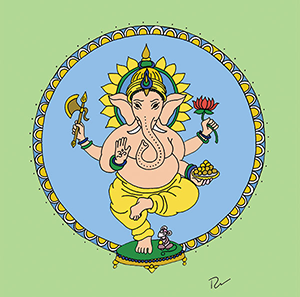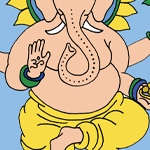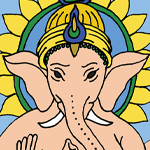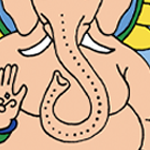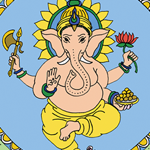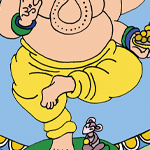Download artwork on our FREE STUFF page!
Ganesha Meaning & Symbolism
The Amazing Qualities of a Beloved Hindu God
Ganesha meaning reveals the amazing qualities of one of the most well-known and popular deities in the Hindu pantheon. He is also known as Ganapati or Lord Ganesh. He is the colorful and memorable elephant-headed son of Shiva and Parvati. This deity is commonly believed to be the ruler of new beginnings, success, wisdom, removing obstacles, letters, and learning.
Table of Contents
Share this page with a friend!
Origin of Ganesha
The symbolic and psychological meaning of Ganesha primarily centers around his role as the lord of new beginnings and the overcomer of obstacles. He is thought to bring good luck. Mantras and prayers to Ganesha are often used at the beginning of an undertaking. Ganesha is an unusual and beloved part of Hindu tradition.
How Ganesha Was Born
Tales of Ganesha’s origins differ widely. In some stories, Parvati created him from clay. Another legend says that Parvati created Ganesha from the soap suds in her bath. Another myth claims that Shiva’s laughter created him. In yet another tale, Ganesha simply appeared mysteriously and was found by Shiva and Parvati. Ganesha also has a brother named Kartikeya, the god of war.
Malini, Elephant-Headed Goddess
In a simple version of the story, Ganesha was born from Malini. Malini is an elephant-headed goddess. She drank bath water that Parvati had thrown into a river. Subsequently, Ganesha was born. These stories do not necessarily explain Ganesha meaning completely. The longer version of Ganesha’s origins below involves the separation and eventual reunion of Shiva and the goddess Parvati.
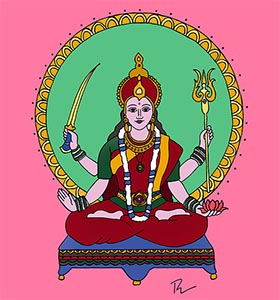
Download artwork on our FREE STUFF page!
Shiva and Parvati: Parents of Ganesha
Ganesha’s mother Parvati and his father Shiva have very different personalities. Parvati is loving and devoted. Shiva is austere and fierce. Some legends suggest that they had a disagreement about whether or not to have children. As a result of this disagreement, Shiva and Parvati separated.
Separation of Parvati and Shiva
During their long separation, Parvati realized that she could create a child for herself without Shiva’s assistance. After all, she is a goddess. In this version of the story, Parvati breathed into the foam in her bath. Her son Ganesha appeared. At the time, Ganesha had the appearance of a normal boy.
Ganesha As Parvati’s Defender
As Ganesha grew up, he became his mother’s defender. Shiva had been absent a long time and many suitors were coming to the palace door. One day Shiva himself appeared. Not knowing his son (clearly his paternity can be debated), he thought that someone had taken his place.
Shiva Kills Ganesha
Shiva immediately challenged Ganesha, attacked him and cut off his head. Clearly, this reckless murder was a huge obstacle interfering with Shiva’s quest to reunite with Parvati. Realizing his horrendous error, Shiva ran into the forest.
Shiva Brings Ganesha Back to Life
Shiva saw an an old elephant in the forest. Fortunately, the elephant was a Shiva devotee. The elderly elephant offered to assist him. When Shiva explained the situation, the elephant allowed himself to be sacrificed. Shiva rushed back to the palace and magically joined the elephant’s head to the body of his son, thereby bringing Ganesha back to life.
Watch nearly 300 videos on our YouTube channel!
Ganesha Symbolism: Overcoming Obstacles
The story of Parvati and Shiva’s separation and reunion explains why Ganesha is viewed as the overcomer of obstacles. By magically fusing the elephant head to his son’s body, Shiva brought his son back to life. In this way, Shiva overcame the seemingly insurmountable obstacle of his son’s death that would have blocked his reunion with Parvati.
Ganesha and New Beginnings
This was a new beginning for the entire family. In fact, Ganesha received his new name after undergoing this ordeal and transformation. Interestingly, although he is known for removing obstacles, Ganesha sometimes places obstacles in the path of those who need to be checked.
Ganesha & Root Chakra Symbolism
Ganesha is associated with the root chakra at the base of the spine. The heaviness of an elephant connects them to the earth. This chakra is the foundation for the other energy centers located further along the spine.
Role of the Root Chakra
This chakra establishes a connection to your physical body, the earth, and the environment. The base chakra is associated with survival instincts for food, shelter, safety, comfort, and belonging. “Lam” (lum) is the seed syllable for the base chakra. The base chakra is said to support all of the other chakras.
Organs Governed by the Root Chakra
Most sources say that the base chakra governs the lower part of the body, including the legs, hips, lower back, and lower spine. These generally provide a strong foundation for physical health and a platform for our presence in the world.
Related Chakra Articles
Ganesha Symbolism & Iconography
Ganesha is a joyful being associated with extensive symbolism. Ganesha’s symbols help the viewer to understand the significance of this unusual deity. Explanations for Ganesha’s more common symbols are given below. These symbols are based on artwork and statues depicting Ganesha.
Symbolism of Ganesha’s Large Belly
Ganesha’s large stomach indicates that he contains all of the universes (cosmic eggs) of the past, present, and future. Ganesha’s belly also represents the ability to digest all experiences in life. Finally, the large belly of Ganesh symbolizes prosperity and abundance. This includes an abundance of food and all material possessions.
Ganesha’s Elephant Head Symbolism
Elephants use their heads to break paths through the forest. This symbolizes breaking through obstacles on every level. In addition, elephants have small eyes in proportion to their large heads. This symbolizes the ability to focus and concentrate.
Symbolism of Ganesha’s Small Eyes
In addition, elephants are purported to see things bigger than they actually are. This is connected with the psychological symbolism of humility and the surrendering of pride. On the other hand, the mouth of an elephant is proportionately large. This represents the natural desire to enjoy food and life.
Symbolism of Ganesha’s Large Ears
Ganesha’s large elephant ears represent willingness to listen and bring together ideas. This creates success in human affairs. Ganesha’s large ears also indicate the wisdom of hearing all sides of an issue. In the natural world, the large ears of the elephant help to keep them cool in a hot desert environment. The blood vessels of the ears are close to the skin and release heat.
Ganesha’s Trunk Symbolism
Ganesha’s trunk is able to hold anything in the universe. This symbolizes the idea that successful people hold whatever life brings. The trunk of an elephant has the ability to uproot large trees or to pick up a small needle. This signifies mastery in both the physical world and in the world of more subtle energy and vibrations. Next to the trunk are two tusks.
Broken Tusk Symbolism
Sometimes one of the tusks (the left one) is depicted as broken. Ganesha’s two tusks represent wisdom and emotion – the right being wisdom and the broken left representing emotion. His broken tusk tells people that they must overcome their emotions with wisdom to attain perfection.
Symbolism of Ganesha’s Arms
Ganesha’s four-armed form represents the inner attributes of the subtle body: mind, intellect, ego, and conscience. In addition, Ganesha’s four arms possess four different symbolic objects: an axe, a lotus, a plate of sweets and a symbol of OM in his palm.
Ganesha Symbolism & Video Shorts
Watch nearly 300 videos on our YouTube channel!
Symbolism of Ganesha’s OM
The hand with the OM symbol is held in a traditional gesture of blessing. Ganesha can be pictured with anything from two to 16 arms. The four-armed version is the most common.
Symbolism of Ganesha’s Axe
Ganesha’s axe symbolizes cutting off desires. He can also destroy obstacles or move a person to the right path with his axe. The axe also symbolizes the power to cut the bonds of ignorance. Sometimes a pen is depicted in place of the axe. In this case, the pen represents knowledge that can remove ignorance as effectively as the power of an axe.
Symbolism of Ganesha’s Yellow Clothing
Ganesha wears yellow as a reminder to all to cultivate purity, peace, auspiciousness, self-control, and truthfulness. Yellow is Ganesha’s favorite color. Yellow is the color of tumeric, a spice that has symbolic meaning associated with the sun, abundance and wisdom. Tumeric is used in Hindu weddings and other significant rituals.
Symbolism of Ganesha’s Blessing Hand
One of Ganesha’s hands is typically turned towards the viewer in a gesture of blessing, refuge, and protection. This hand position is called the Abhaya mudra. A mudra is a symbolic gesture said to send energy out from the body for a specific purpose. The OM symbol inscribed on Ganesha’s palm represents the sound of all of creation.
Symbolism of Ganesha’s Lotus Flower
One of Ganesha’s hands holds a lotus flower. This symbolizes the realized inner self. The color red indicates activity in the world. The lotus flower is one of the most heavily used symbols in the East. Many deities are depicted sitting on a lotus flower. The lotus symbolizes attaining enlightenment as the ultimate fulfillment of life.
Why the Lotus is India’s National Flower
Lotus flowers mean purity, rebirth and divinity. As a consequence, the lotus is the national flower of India. Additionally, the blue lotus is the sacred water-lily of both Hinduism and Buddhism. In addition, lotus roots are used widely in Asian cooking. In terms of colors, lotus are usually white or pink. They can also be yellow, red, purple or blue. Learn more about Flower Color Meanings.
Meaning of Ganesha’s Sweets
Sometimes Ganesha is pictured with common Indian sweets in his hand. He is known to have a fondness for sweets. However, Ganesha’s treats are not merely for the pleasure of taste. Instead, these treats symbolize the rewards for a life of service and the eternal sweetness that is available following many lifetimes of right living.
Ganesha Mouse Symbolism
The mouse or rat represents ego and the wandering of the human mind. Ganesha stands over the mouse or rat, meaning that he has complete control over ego and the mind. The mouse finds food in the darkness. This food is like negative mental traits that dominate during times or darkness or ignorance. Ganesha has used wisdom to conquer all negative mental traits.
Watch nearly 300 videos on our YouTube channel!
Mantra: Ganesha Sharanam Meaning
There are a number of mantras to Ganesha. This video is a variation of one of the more common ones: Ganesha Sharanam, Sharanam Ganesha (2x), Sayisha Sharanam Sharanam Ganesha Sharanam (2x). Meaning: I take refuge (sayisha) in Ganesha. I surrender (sharanam) to Ganesha.
Qualities of Ganesha
Ganesha is associated with success, wisdom, learning and writing. Ganesha is a patron of the arts and sciences. In the natural world, elephants are known for high intelligence. In fact, they have the largest brain of any land animal.
Ganesha as a Mentor
In addition, elephants are artistic, can use tools and mimic human speech. In keeping with these things, Ganesha is a very curious and intellectual god. Thus, he holds great meaning in Hinduism as the god of intellect and wisdom.
Ganesha as a Spiritual Teacher
In contrast with his reputation as the remover of obstacles, Ganesha is occasionally thought to place obstacles in the path of those who need to be checked to establish a stronger foundation before moving further forward.
Role of Ganesha as Guru
Obstacles help the student to stay focused on immediate challenges in life. This is sometimes the role of an archetypical guru: to place obstacles along the path of the student to help them gain mastery. Thus, Ganesha meaning can include both help and hindrance.
Watch nearly 300 videos on our YouTube channel!
Sweetest Ganesha Story Ever
There was an argument among the gods in heaven: which of the sons of Shiva and Parvati was the wisest? Shiva and Parvati have two sons and one daughter. One son is Kartikeya. Kartikeya has a normal human form. The other son is Ganesha, who has an elephant’s head and an enormous body. (They also have a daughter, Akosha Sundari, but she is not part of this story.)
Brahma Offers a Golden Mango
Shiva and Parvati went to Brahma, the creator god, for the answer to the question on their sons’ relative intelligence. Brahma does not answer the question but sends his own son Narad to offer a golden mango to Shiva and Parvati. He also sends the message that whoever eats the mango will be granted immortality and supreme knowledge.
A Competition for Immortality
Shiva and Parvati set up a contest for one of their sons to win the mango as a prize. The son who circles the world three times first will prove himself and gain immortality. Each of the gods and goddesses have typical animals that they ride. Ironically, Ganesha rides a mouse (or rat) while the slim Kartikeya rides a mythical animal similar to a peacock. Ganesha realizes that he has no chance to win by conventional means. He comes up with an alternate plan.
Ganesha Views His Parents Symbolically
The starting gun goes off and the race begins. Kartikeya takes off at top speed. Ganesha begins to ride his mouse around where his parents are standing. They look at him in confused concern. He continues to ride around them three times. At the end, he announces, “You, my parents, are my entire world. I have just ridden around my world three times.”
Ganesha Wins the Race
They are touched with his sentiment and impressed with his ingenuity. Ganesha wins the race, the golden mango, his parent’s appreciation, and his own immortality. Ganesha has proven himself to be the wisest son of Shiva and Parvati.
Author Kathleen Karlsen
Kathleen Karlsen is a musician, artist, writer and speaker. She is the author of two books (Flower Symbols and Vocal Medicine) and over 200 articles. Kathleen, her husband Andrew, and their five children live in Bozeman, Montana. More about Kathleen Karlsen.
GANESHA MEANING ARTICLE SUMMARY
Ganesha is well-known in the East as an aspect of God to appeal to at the beginning of new endeavors. He is the Hindu god of overcoming, a fusion of an elephant head and a human body, something like Western superheroes. This article covers the origins of Ganesha, his mantras, symbolism related to Ganesha, his elephant head and the connection between Ganesha meaning and the root chakra.

